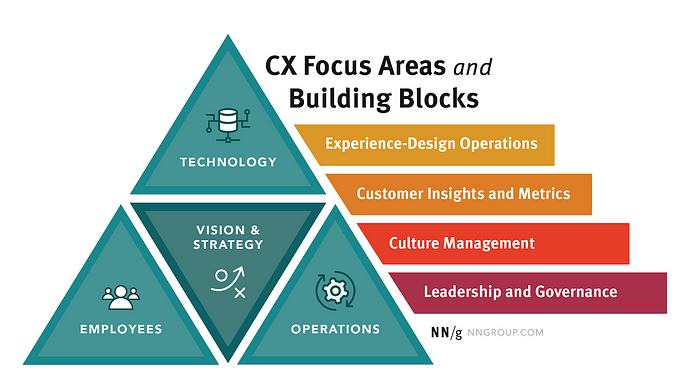Clearing the path to excellence: Why defining CX, digital transformation, and customer service is essential
Background:
It might surprise most of you. However, within the dynamic business landscape, there exists a significant amount of confusion and misinterpretation surrounding the concepts of Customer Experience (CX), Digital Transformation, and Customer Service. These misunderstandings have led to negative consequences and hindered organizations from delivering consistent and exceptional experiences. In the article “Executives Need to Invest in Understanding the Customer Experience” (2023), Joe McKendrick and Andy Thurai emphasize the importance of delivering superior CX, which extends beyond customer-facing departments and requires a cultural shift towards pervasive information sharing and intent analysis across the entire organization. However, misconceptions persist, impeding organizations from fully embracing the transformative potential of these concepts.
From my experience in global transformation projects across financial sectors these years, one common example of misinterpretation involves senior business leaders perceiving Digital Transformation merely as a technological implementation, disregarding the broader organizational implications. This oversight often results in a failure to incorporate design thinking principles into the transformation process, leading to a limited understanding of customer needs and preferences. Furthermore, some professionals mistakenly view CX solely through the lens of customer service, overlooking its roots in design practices. Kim Salazar, Nielsen Norman Group, (2021) proposes the CX transformation framework that can be used as a lens to guide CX transformation and establish an operational structure for the ongoing management of CX.

Key Consequences: (interrelated)
1. Misguided Approach:
Misinterpretation of CX, digital transformation, and customer service can lead to misguided approaches, causing organizations to struggle in tackling challenges effectively. This can result in frustration and dissatisfaction among delivery teams. For instance, it is crucial to differentiate between business process mapping and customer journey mapping, as well as to distinguish between customer segmentation strategies or persona strategies. By understanding these distinctions, organizations can develop more accurate and effective approaches to address customer needs and deliver exceptional experiences.
2. Misallocation of Resources:
Lack of clarity surrounding CX, digital transformation, and customer service can lead to misallocation of resources. Organizations that fail to recognize the transformative potential of CX may invest in technologies or strategies that do not align with customer needs or business objectives, resulting in wasted resources. For instance, while technology capability is crucial, organizations must also prioritize CX capability as it serves as the foundation for all transformation efforts. Proper CX leadership support or decision-making driven by CX or design thinking are essential to avoid such misallocation. By ensuring alignment between resources and customer-centric goals, organizations can optimize their investments and effectively drive CX transformation.
3. Inhibited Innovation and CX Transformation:
Confusion surrounding CX, digital transformation, and customer service creates barriers to innovation and hampers CX transformation initiatives. Without a clear understanding of the end-to-end nature of CX, organizations miss out on leveraging crucial customer insights and struggle to implement comprehensive strategies that drive meaningful customer experiences and disruptive innovations. By clarifying these concepts and embracing a holistic view of CX, organizations can break down these barriers, unlock innovation potential, and implement transformative strategies that result in exceptional customer experiences and groundbreaking innovations.
Conclusion:
In conclusion, it is imperative to address the confusion surrounding CX, digital transformation, and customer service to deliver consistent and exceptional customer experiences. Organizations must recognize the transformative potential of these concepts and clarify their distinctions to avoid misguided approaches, resource misallocation, and barriers to innovation and CX transformation. An integrated approach to CX, combining traditional practices with user-centered design processes, is often overlooked, as highlighted by Ewan Duncan et al. in their article “CX without design only gets you halfway” (2022). By embracing design thinking principles and seeking proper design leadership, organizations can gain deep insights into customer needs and preferences, enabling the development of innovative solutions that drive meaningful experiences.

With a clear understanding of CX, digital transformation, and customer service, organizations can proactively leverage their potential, deliver exceptional experiences, and stay ahead in the ever-evolving digital landscape. By navigating the complexities of the industry, unlocking innovation potential, and embracing design thinking, organizations position themselves for sustainable success in the AI age. In addition, recognizing the broader evolution of the design industry is crucial, as it impacts the roles of designers, product owners, project managers, and product managers. Therefore, organizations should prioritize design leadership to accurately interpret and support these changes.
—
Note: Many designers may find it surprising to grasp this reality, but it is based on my observations as a designer working in the field of business consulting these years.
The opinions and thoughts shared are solely my own, and do not reflect EY’s views on any of the issues.
